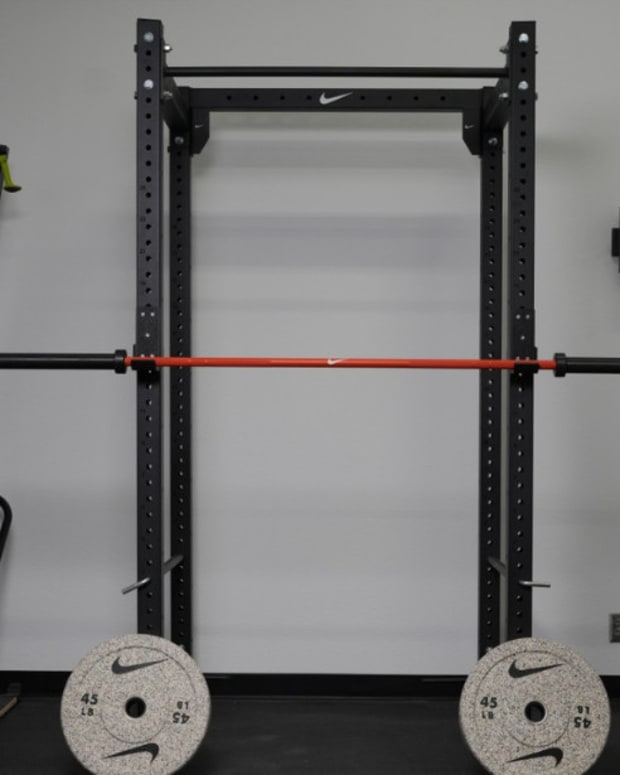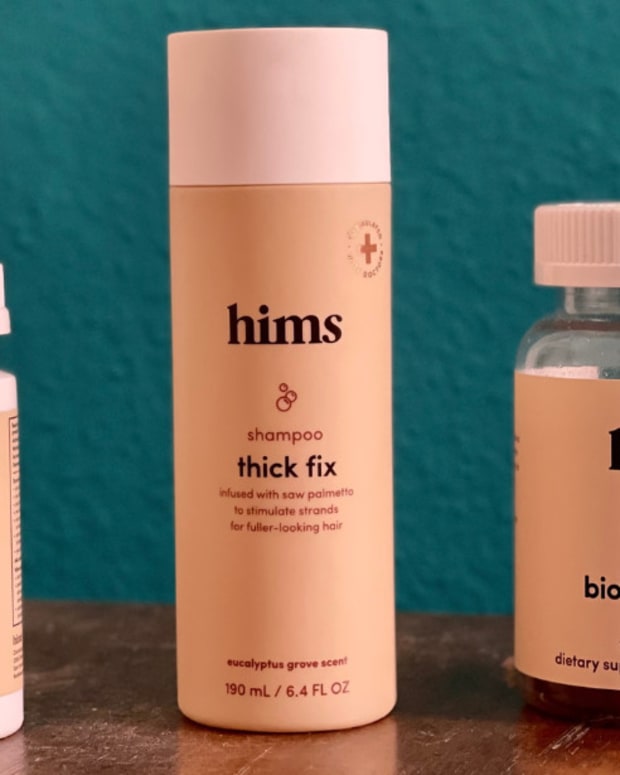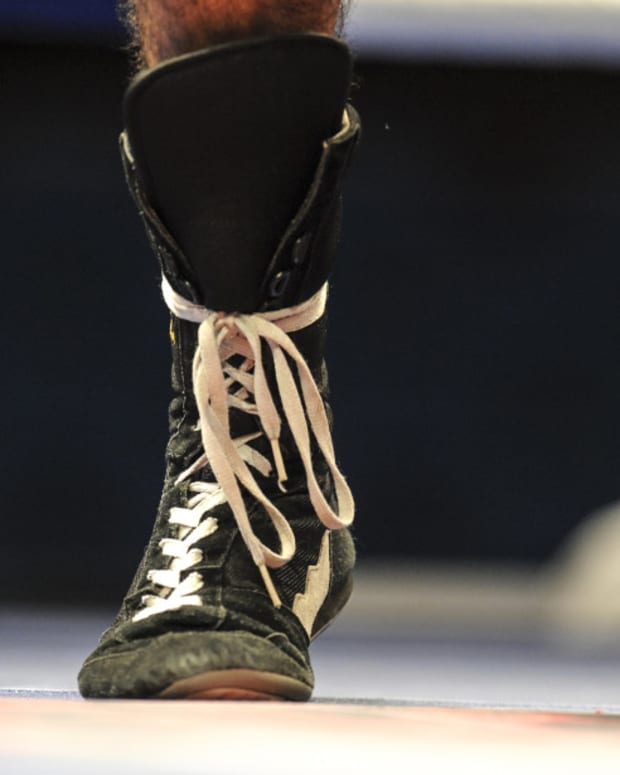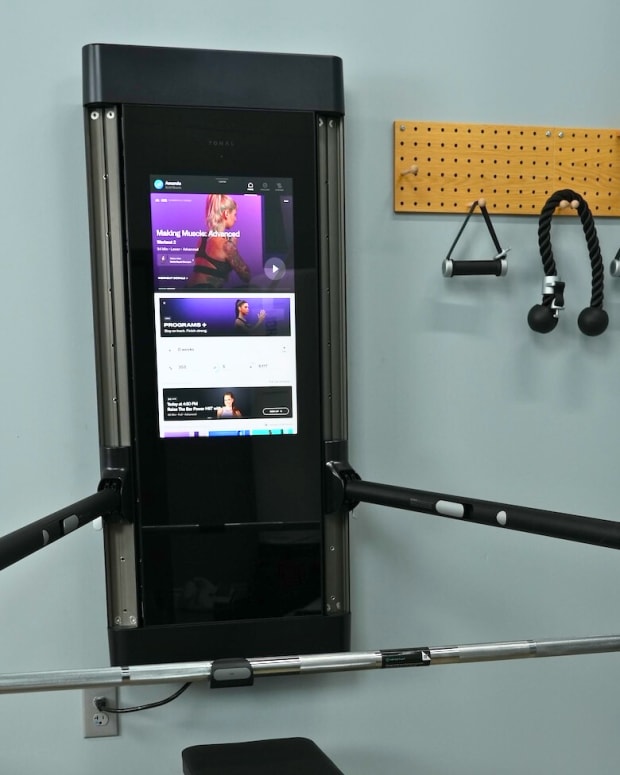The products featured in this article have been independently reviewed. When you buy something through the retail links on this page, we may earn commission at no cost to you, the reader. Sports Illustrated editorial staff are not involved in the creation of this content. Learn more here.
An Olympic bar is a highly versatile piece of gym equipment, and a staple in any strength training program. They’re designed to be used for a variety of movements, allowing you to train for strength, sports performance, Olympic lifting, CrossFit and more.
With so many companies creating Olympic barbells, it can feel overwhelming trying to choose the best barbell for your lifting needs. After all, if you’ve ever trained in a commercial gym, you’ve likely realized that most barbells look very similar to one another, yet there are hundreds of options, with different materials, functions and price points.
In this guide, we’re sharing our top picks for the best Olympic lifting barbells of 2024, whether you’re a competitive lifter or a complete beginner, and we’ve included options to match any budget.
Our Picks for the Best Olympic Barbells of 2024:
- Best Stainless Steel Olympic Barbell: REP Fitness Gladiator Olympic Barbell
- Best Women’s Olympic Barbell: Fringe Sport Women’s Olympic Barbell
- Best Olympic Barbell for Perfecting Technique: REP Fitness Technique Barbell
- Best Budget Olympic Barbell: Sunny Health & Fitness 86” Olympic Weight Bar
- Best Splurge Olympic Barbell: Eleiko Performance Weightlifting Bar
- Best Olympic Barbell for Beginners: Synergee Essential Barbell
- Best Cerakote Olympic Barbell: Titan Cerakote Olympic Barbell
- Best Chrome-Coated Olympic Barbell: American Barbell Performance Bearing Bar
- Best Needle Bearing Olympic Barbell: Get RXed Oly Weightlifting Bars
- Best IWF-Approved Olympic Barbell: Rogue 28mm IWF Weightlifting Bar
- Best Black Zinc Olympic Barbell: Force USA Gunner Barbell
- Best-Rated Olympic Barbell on Amazon: Annzoe Olympic Barbell
Best Stainless Steel Olympic Barbell: REP Fitness Gladiator Olympic Barbell
Key Features:
- Length: 79.1 inches (15 kilograms); 86.6 inches (20 kilograms)
- Material: Hard chrome
- Weights available: 15 kilograms (33 pounds) or 20 kilograms (44.1 pounds)
- Weight capacity: 1,500 pounds
The REP Fitness Gladiator Olympic Barbell combines exceptional quality and an affordable price. This would work very well in home gyms and commercial gyms alike.
The Gladiator barbell is designed for Olympic weightlifting, but can be used for nearly any type of training. It features needle-bearing sleeves, IWF knurl markings and ribbed sleeves for a smooth and efficient lift. The barbell is available in 15 kilogram (33 pounds) and 20 kilogram (44.1 pounds) versions, and the 20 kilogram bar can be upgraded to a full stainless-steel external coating for added corrosion resistance.
With a weight capacity of 1,500 pounds, lifters of all levels will be able to use this bar without having to worry about damaging it over time. Many reviews also noted that this bar is exceptionally quiet when dropped, making it a great choice for a home gym where excessive noise could be an issue.
Pros:
- High-quality durable design
- Very affordably priced for such a durable bar
- Quiet use when being dropped
Cons:
- Weightlifting knurling may not be suitable for powerlifters
Best Women’s Olympic Barbell: Fringe Sport Women’s Olympic Barbell
Key Features:
- Length: 79 inches
- Material: Alloy steel with black zinc plating
- Weights available: 15 kilograms (33 pounds)
- Weight capacity: 1,000 pounds
Women’s barbells are typically a little bit shorter and lighter, and the Fringe Sport Women’s Olympic Barbell is one of the best on the market.
The bar features a 25 millimeter shaft diameter, while standard barbells usually feature 28 to 32 millimeter shafts. The slightly smaller diameter allows for greater control on Olympic lifts, particularly the overhead lockout position, and transitioning your grip throughout the movement. For anyone with smaller hands, this allows more control and greater safety on most lifts.
The knurling follows IWF standards, so you know this barbell is specifically designed for Olympic weightlifting, rather than powerlifting or general training use. The barbell features a black zinc coating, which is similar to black oxide, but provides greater resistance against rust and corrosion.
Fringe says that the bar has more spin thanks to the needle bearing cartridges, but they may require oiling every so often. This shouldn’t be a huge deal, but something to be aware of, as many barbells don’t require regular oiling, so you may need to set yourself reminders to periodically oil the bar after regular use.
Pros:
- Black zinc plating provides a unique style (Fringe nicknames this barbell “Black Magic”)
- 25 millimeter diameter for enhanced grip and control
- 1,000-pound weight capacity means lifters of all levels can use this barbell
Cons:
- You’ll need to periodically oil the barbell to keep it spinning smoothly
Best Olympic Barbell for Perfecting Technique: REP Fitness Technique Barbell
Key Features:
- Length: 72 inches
- Material: Aluminum
- Weights available: 15 pounds
- Weight capacity: 200 pounds
If you’re new to Olympic lifting, it often takes quite a bit of practice and help from an experienced coach, to really dial in your technique. After all, explosively moving a barbell from the floor to an overhead position requires precision, accuracy and perfect technique, which can be difficult for beginners to learn on a standard barbell.
For those new to lifting, a standard barbell may simply be too heavy to control, and learn proper technique with.
That’s where the REP Fitness Technique Barbell saves the day. This training bar is specifically designed to help beginners learn correct lifting techniques with minimal load or risk. At 15 pounds, this barbell is significantly lighter than standard training barbells, making it much easier to safely control, yet it still feels like a standard barbell.
The barbell only holds up to 200 pounds of weight and has a shorter sleeve length (the part of the barbell that holds the plates), but that’s by design. This is meant for perfecting your technique, not heavy training, so once your form is perfect and you’re used to using the training bar with light bumper plates, you can move up to the heavier barbells found in standard training facilities.
At 72 inches, it’s slightly shorter than standard barbells, but still works with squat racks and power racks, so you won’t have to re-learn your technique when you transition to standard barbells.
If you’re a beginner to Olympic lifting, or run a gym that helps beginners, this is the perfect “practice” barbell to safely practice your lifting technique.
Pros:
- Very lightweight barbell, perfect for training
- It’s still long enough to work with standard squat racks
- The spin is reduced from standard barbells, making it more beginner-friendly
Cons:
- It only holds up to 200 pounds, so this is only for practice, not heavy training
- At $129, you’re making a moderate investment in something you’ll no longer use once you’re past the beginner phase
Best Budget Olympic Barbell: Sunny Health & Fitness 86” Olympic Weight Bar
Key Features:
- Length: 86 inches
- Material: Steel
- Weights available: 44 pounds
- Weight capacity: 1,500 pounds
Olympic barbells are available in a wide range of price points, and if you’re looking for a high-quality barbell that won’t break the bank, the Sunny Health & Fitness 86-inch Olympic Weight Bar is a great choice for your home gym.
This barbell is very similar to ones you’ll see in your standard commercial gym. It’s designed for any training style, so it has knurling for both Olympic lifting and powerlifting, rather than specializing in one type of lifting. Compared to a pure Olympic lifting barbell, this has less spin, and less whip, or bendiness of the bar.
After all, if you’re not Olympic lifting, you don’t want a bar that easily bends and spins on your regular lifts, like squatting and bench pressing. Powerlifters can also use this barbell, though it’s not a pure powerlifting bar either, so it’s not as stiff as most power barbells.
Overall, if you’re not looking to specialize in any particular style of lifting, and don’t want to invest significant money to have every type of a barbell available, this is a good barbell suitable for any type of training.
Pros:
- High-quality, multi-use barbell
- Includes knurling for powerlifting and Olympic lifting
- Only costs $199 and will cover any type of lifting
Cons:
- Not quite as much whip and spin as a pure Olympic barbell
- The knurling may feel a bit harsh for new lifters
Best Splurge Olympic Barbell: Eleiko Performance Weightlifting Bar
Key Features:
- Length: 86.61 inches
- Material: Proprietary Swedish steel
- Weights available: 20 kilograms (44 pounds)
- Weight capacity: 1,500 kilograms (3,306 pounds)
If budget is NOT an issue, and you want the best of the best, the Eleiko Performance Weightlifting Bar is designed for serious trainees and professional lifters, so you know the quality is top-notch. This barbell was specifically engineered for maximum performance and comfort during Olympic lifting.
High-quality, proprietary Swedish steel provides a durable yet flexible barbell, specifically designed for explosive Olympic lifting. The knurling is very mild, so it provides grip without tearing up your hands as you explosively move the barbell around.
With a 3,306-pound weight capacity, more than double the capacity of most other barbells on the market, this bar is built to last and withstand any type of training. In fact, Eleiko even offers a 12-year warranty, provided the bar is used properly with padded flooring to drop the bar on.
This bar isn’t cheap, but if you’re serious about Olympic lifting, this is the most luxurious, high-quality barbell on the market.
Pros:
- Extremely durable, yet flexible Swedish steel
- Very mild knurling to keep your hands comfortable while training
- Excellent whip and spin for Olympic lifting
Cons:
- At $879, this barbell is far from cheap
- It’s designed specifically for Olympic lifting, and won’t work well for other types of training
Best Olympic Barbell for Beginners: Synergee Essential Barbell
Key Features:
- Length: 86 inches
- Material: Steel
- Weights available: 40 pounds
- Weight capacity: 400 pounds
If you’re a beginner lifter, you likely want a standard barbell that will last a long time, allow you to train however you want and won’t cost an arm and a leg. After all, beginners likely won’t need a specialty bar, or even have a lifting speciality yet, so this is perfect for your first year or two of training, if not longer.
We’ve already covered the best technique barbell, and once you’ve got your technique down, the Synergee Essential Barbell should be your next step. It has a 400 pound weight capacity, less than standard barbells, and at 40 pounds, it weighs four to five pounds less than other barbells.
However, while it holds less weight and is slightly lighter, it only costs $159.95, an easy next step for beginners who want to train, but aren’t ready for a more expensive, specialty barbell.
The Synergee Essential Barbell can be used for both Olympic lifting and powerlifting, so if you’re a beginner to lifting and haven’t decided to specialize in one or the other, this allows you to train in both styles as you’re getting started to see what you like.
Once you’re strong enough to lift more than 400 pounds, you’ll need to upgrade your barbell. Until then, this is an excellent budget barbell choice for new lifters.
Pros:
- Multi-purpose budget barbell that allows beginners to try a variety of lifting styles
- Very affordable
- Works with standard plates
Cons:
- Once you can lift more than 400 pounds, you’ll need a stronger barbell
- This barbell is only designed for home gyms, not commercial use
Best Cerakote Olympic Barbell: Titan Cerakote Olympic Barbell
Key Features:
- Length: 86.75 inches
- Material: Non-recycled American steel
- Weights available: 20 kilograms (44 pounds)
- Weight capacity: 1,500 pounds
If you want to invest in a Cerakote barbell, look no further than the Titan Cerakote Olympic barbell.
What’s so special about Cerakote? Well, Cerakote is known for its resistance to abrasion and rust, as well as its ability to come in many different colors.
It was originally used to coat firearms to make them more resistant to rust and abrasion, and now many barbells are coated in Cerakote. Barbells often wind up covered in sweat, chalk, water and other stuff that can cause the coating to break down and rust, especially in commercial gyms.
Cerakote provides exceptional corrosion protection, helping your barbell last. As an added bonus, because Cerakote is available in different colors, you can choose from four different finishes when purchasing your Titan Cerakote barbell: black, blue, red or bronze.
It’s specifically designed to be a hybrid barbell for both Olympic lifting and powerlifting. It may not be a specialty bar, but its durability and versatility make it the perfect choice for lifters who like to mix things up at home, or gym owners who need to accommodate all training styles.
Pros:
- Cerakote coating provides exceptional rust and corrosion protection
- Four different color choices
- Versatile barbell that can be used for multiple lifting styles
Cons:
- If you’re looking for a pure Olympic lifting barbell, you may need something else
- Medium knurling, which may be a bit rough for some
Best Chrome-Coated Olympic Barbell: American Barbell Performance Bearing Bar
Key Features:
- Length: 79 inches or 86 inches
- Material: Hard steel with chrome coating
- Weights available: 15 kilograms or 20 kilograms
- Weight capacity: Unknown (not disclosed in the brand specs)
Most barbells are made from a hard steel, but without protection, this steel is exposed to the elements and often rusts faster. Plus, the knurling on a bare steel bar can feel a bit harsh, and bite into your hands more.
With a chrome coating, you’ll add a shiny layer of protection, which minimizes rush without changing the look of the barbell. While zinc or Cerakote coatings can provide a nice matte finish, a chrome finish maintains the shiny, polished appearance.
The American Barbell Performance Bearing Bar is available in both 15-kilogram and 20-kilogram sizes, and both feature proprietary bearings that allow the spin to increase as the weight gets heavier. As you get stronger, the lift will feel even smoother.
It’s built to IWF specifications and great for Olympic lifting, and the chrome finish provides extra protection against both rust and damage from dropping the barbell.
Pros:
- Hard steel with chrome finish, built to last
- Proprietary system increase the spin and rotation as the weight increases
- Designed for Olympic lifting
- Available in men and women’s sizes
Cons:
- It’s not the cheapest barbell
Best Needle Bearing Olympic Barbell: Get RX’d Oly Weightlifting Bars
Key Features:
- Length: Not disclosed, but the women’s bar has a shorter loadable length, so is likely shorter.
- Material: Steel
- Weights available: 15 kilograms or 20 kilograms
- Weight capacity: 1,200 pounds or 2,000 pounds
When it comes to the spin and rotation on a barbell, higher spin results in a smoother lift, and needle bearings provide some of the smoothest spin of any barbell.
The Get RX’d Oly Weightlifting Bar is available in two sizes, both of which are specifically designed for maximum comfort and safety while performing high-volume Olympic lifts, as you’d often find in CrossFit.
The hard steel is flexible enough to lift, with enough tensile strength to withstand heavy loads of up to 1,200 pounds on the women’s bar, and 2,000 pounds on the men’s bar. The men’s barbell uses spring steel, which is often used in shock-absorbing springs, and provides better whip and flexibility when training.
If you’re looking for maximum comfort and a smooth lift, it’s hard to beat the Get RX’d. You’ll also receive a lifetime warranty, so this could be the last barbell you ever need to purchase.
Pros:
- High spin thanks to the needle bearings, and spring steel on the men’s bar
- Lifetime warranty
- Durable, comfortable bars for Olympic lifting
Cons:
- Not the cheapest barbell
Best IWF-Approved Olympic Barbell: Rogue 28mm IWF Weightlifting Bar
Key Features:
- Length: 86.6 inches
- Material: Steel with zinc finish
- Weights available: 20 kilograms
- Weight capacity: Not listed
The IWF, or International Weightlifting Federation, ensures that barbells are the correct size and weight for competition, and it has very high standards for which barbells it’ll officially approve.
The bars need to be extremely precise with minimal variance, suitable for international competition. As Rogue Fitness says, “approval from the IWF (International Weightlifting Federation) is equivalent to a restaurant getting its Michelin stars,” so it’s a big deal that this barbell meets IWF standards.
Each sleeve contains five needle bearings for optimal spin, and both the shaft and sleeve are coated in a bright zinc finish. This barbell is built to last, and includes a lifetime warranty against bending, assuming standard, safe usage. The cap on each end features official IWF branding, so you know you’re getting the best of the best.
Recreational lifters may not need this much precision, as non-IWF barbells are usually still very close to the specifications, but if you plan to compete or use this bar in a competition, you know you’re getting a high-quality barbell that will last a lifetime.
Pros:
- IWF-certified for high precision
- Bright zinc finish protects against rust and corrosion
- Needle bearings provide a smooth, comfortable lift
Cons:
- On the more expensive end thanks to its IWF approval
Best Black Zinc Olympic Barbell: Force USA Gunner Barbell
Key Features:
- Length: 86.6 inches
- Material: Stainless steel with a black zinc coating
- Weights available: 20 kilograms (44.1 pounds)
- Weight capacity: 1,500 pounds
The Gunner barbell is a versatile option for your home or commercial gym, suitable for a range of lifts from deadlifts to bench press to power cleans. The sleek black look stands out from the normal chrome finish, and this barbell is versatile enough for nearly any form of training.
The knurling is moderate to avoid tearing up your hands, and if you want some extra grip, the zinc finish is designed to work well with lifting chalk. It features stainless steel bushings and five-needle bearings for a smooth spin, and a grooved pattern on the sleeves to keep your weight plates securely in place.
It doesn’t have quite as much whip as a pure Olympic lifting bar, as it’s designed to be versatile enough for any sort of lifting. Too much whip on non-explosive movements could create some instability, and you don’t want the bar wiggling around and bending while performing something like a bench press.
As many people perform a variety of lifts, an Olympic barbell that provides this much versatility for a variety of training styles is a fantastic option for a home gym.
Pros:
- Black zinc finish for anti-corrosion and enhanced grip with chalk
- Moderate knurling that provides a secure grip without tearing up your palms
- Enough whip to use for Olympic lifting, while still being stiff enough to use with standard barbell lifts as well
- Affordable cost
Cons:
- It’s designed to be an all-in-one barbell, so it doesn’t have quite as much whip as a pure Olympic barbell
Best-Rated Olympic Barbell on Amazon: Annzoe Olympic Barbell
Key Features:
- Length: 84.6 inches
- Material: Steel
- Weights available: 35 pounds
- Weight capacity: 700 pounds
Finally, if you prefer to do your shopping with Amazon, and don’t want to order directly from Rogue, Eleiko or any of the other brands on this list, we suggest the Annzoe Olympic Barbell.
The Annzoe Olympic barbell isn’t the most durable barbell, as it only has a 700-pound weight capacity, but for many recreational lifters, this is more than enough.
At 35 pounds, it’s a little bit lighter than most standard men’s barbells, but this may be a good thing, depending on your experience level. It’s also priced to fit most budgets, making it a great choice for someone who’s building a home gym, and doesn’t need the most expensive option.
Pros:
- High-quality steel
- At 35 pounds, it’s slightly lighter than standard barbells, which may be good for beginners
- It ships from Amazon, which many trust more than independent brands
- It’s very affordable
Cons:
- It’s not the most durable barbell, and has a lower weight capacity of 700 pounds. Most Olympic barbells can handle at least 1,500 pounds, if not more.
What Are Olympic Barbells?
Olympic Barbells vs standard barbells
Olympic barbells are typically longer and have a larger diameter than standard barbells. While standard barbells are usually in the 15-25 pound range, Olympic barbells are usually between 33 and 45 pounds.
The 45 pound bars at your local gym are sort of a hybrid. They look like Olympic lifting barbells, but often don’t have the same whip and spin, as they’re designed for all types of training, rather than one specialization like Olympic lifting.
Olympic barbells also have rotating sleeves at the ends and more “whip,” which allows the bar to bend more, and absorb the shock from fast movements and drops from shoulder height or above. The weights are often dropped onto hard surfaces, so the whip in the bar allows it to absorb the impact without permanently bending.
The spin allows the weights to move around, rather than being locked in place. As you quickly snap the bar from the ground, shin height or waist height to an overhead position, this creates a smoother movement with less jarring impact on your joints.
Olympic barbells vs powerlifting barbells
The other specialty barbell is the powerlifting barbell. In powerlifting, the main lifts are the squat, deadlift and bench press, all movements that are slow and controlled.
Because of this, powerlifting barbells are designed to have minimal, if not zero whip, as you don’t want the bar bending much while you’re lifting. You want a stiff, sturdy bar that can handle very heavy weights, not a flexible bar.
Just like Olympic lifting bars are often IWF-certified, which is the International Weightlifting Federation, powerlifting bars are often IPF-certified, the International Powerlifting Federation. While both barbells look similar, they are designed for very different purposes.
Powerlifting barbells usually have different knurling as well, which is the rough, textured part of the barbell. The knurling on powerlifting barbells is often designed to improve your grip while deadlifting and keep the bar from sliding around on your back during heavy squats.
With Olympic barbells, the knurling is usually wider and closer to the ends, as Olympic lifts often require a wider grip. They may not include center knurling to be used for powerlifting.
Olympic Barbells vs specialty barbells
Finally, there are special bars designed for one specific lift, like the safety squat barbell, trap bar or multi-grip bar with hand placements at different angles.
These are generally only used for one specific type of lifting, and aren’t as versatile as an Olympic barbell. For example, a safety squat bar is an excellent choice for those looking to practice their squats, but you really can’t use it for any other exercise.
A multi-grip bar allows you to bench press or overhead press with a variety of angles, but can’t be used for squatting, Olympic lifting or deadlifting.
While these specialty barbells are a nice option to have for your training, they’re generally more expensive, and only work for one specific type of exercise.
Why Buy an Olympic Barbell?
There are several reasons why someone might choose to purchase an Olympic barbell, rather than a standard barbell. The main reason is the improved safety and comfort when performing standard Olympic lifts.
Olympic barbells are designed for advanced weightlifting and are suitable for those looking to train with Olympic lifts. CrossFitters, recreational lifters or those who use Olympic lifts in their workouts could all benefit from using an Olympic barbell.
These specialty barbells have rotating sleeves at the ends, which allows for a more natural feel during exercises such as the snatch and the clean and jerk. A stiff bar, with no spin or whip, could put more stress on the joints in your shoulders and elbows.
Olympic barbells are generally made with higher quality materials and are more durable than standard barbells, making them a good investment for those who plan on using them frequently. They usually hold up to around 1,500 pounds, so advanced lifters of any strength level can use them. The flexible design and whip allows you to use bumper plates and drop the bar safely, without bending it after repeated use.
What Exercises Are Olympic Barbells Best For?
While you could use an Olympic barbell for any type of lift, they’re best for fast, explosive movements, which often involve dropping the weight after each repetition.
Hang cleans, power cleans, clean and jerks and snatches are all excellent exercises to perform with an Olympic barbell. If you train in CrossFit, which often utilizes Olympic lifting, you’ll usually see Olympic barbells, as CrossFitters often drop the weights to the ground after each rep, rather than controlling the weight and slowly lowering it.
Olympic barbells combined with special rubber plates are designed specifically for this dropping, as they absorb the impact and prevent excess wear and tear.
Who Olympic Barbells Are Best For
If you train with any sort of Olympic lifting, you’ll want a specialized Olympic barbell. Standard barbells don’t have enough whip or spin, and the knurling may be in the wrong position.
While you can perform Olympic lifts with stiffer bars, as you get stronger, many lifters experience more wear and tear. And if you’re dropping weights with a standard barbell, you’re more likely to bend the bar over time, since it’s not designed to absorb the shock.
Who Olympic Barbells Are Not Best For
If you’re a competitive powerlifter, you’ll want to use a power bar, which is designed to be very stiff, with minimal bend and maximum grip. Olympic bars often provide too much flexibility to properly use for powerlifting.
What to Look For in an Olympic Barbell
Weight
How strong are you, and how do you plan to train? Nearly all standard barbells weigh 20 kilograms, or 44 pounds. If you’re new to lifting, this may be a bit too heavy.
Women’s barbells are usually around 15 kilograms (33 pounds), and some beginners bars are even less, so if you don’t feel comfortable with a 20-kilogram barbell, start with a lighter weight.
Size
When it comes to size, you’re mainly choosing between diameters. If you have smaller hands, choose a barbell with a 25 millimeter diameter. For everyone else, a standard grip will be just fine. The lengths are usually right around 86 inches for nearly all barbells.
Material
Most barbells are made of steel, but some, like the REP Fitness Technique barbell, may use other materials like aluminum for a lighter weight. As long as your barbell has a high weight capacity, and enough whip for your lifting needs, the material won’t make a huge difference.
Knurling
If you specialize in Olympic lifting, you’ll want to use a barbell specifically designed for your training. This usually means knurling that follows IWF standards, and is a bit wider than a powerlifting bar.
Some manufacturers also use lighter knurling, so the bar doesn’t feel too rough on your hands as you’re going through explosive movements in your training. More aggressive knurling is rougher, to provide a stronger grip, but this often results in more wear and tear on your hands.
Overly aggressive knurling can provide the maximum grip, but be painful on your hands, especially if you’re a newer lifter. You’ll develop calluses eventually, but many Olympic lifters prefer smoother knurling combined with lifting chalk for a safe grip, rather than harsh knurling.
Type of bearings/bushings
Finally, the type of bearing or bushing in your barbell will impact how much spin the bar has. Higher spin and more rotation usually allows for a smoother lift, which is perfect for Olympic lifting, but a bar with high spin usually costs more.
Barbells with bearings generally have a smooth rotation and are better for Olympic lifts, but they are more expensive. On the other hand, barbells with bushings are less expensive, but they have less smooth rotation, and are better suited for lighter weights and home gym use.
If you’re just getting started, you likely won’t notice much of a difference, but if you’re a seasoned lifter, you’ll likely have a strong preference for one type or the other.
Cost
Finally, budget is a factor for most of us, and always needs to be considered. If money is tight, and you’re outfitting a home gym, you’ll likely want a multi-purpose bar built to last, like the Sunny Health & Fitness Barbell.
However, if money’s not really an issue, you can purchase speciality bars designed purely for Olympic lifting, like the Eleiko Performance Barbell.
How We Chose the Best Olympic Barbells
When we assembled our list, we considered a variety of factors: Who’s using the barbell, what sort of training is it for, and what budget do you have?
We made sure to include beginner barbells, barbells with smaller grips, Cerakote barbells and high-end, premium grade barbells. Some of the bars on our list are pure Olympic lifting barbells, and some are more of a hybrid bar, designed to be used with different types of lifting.
Unless you’re a competitive powerlifter who needs a special power barbell, you’re sure to find the perfect barbell for your needs in our guide.
Olympic Barbell Accessories
Finally, it’s important to remember that a barbell is a great start, but you’ll still need other accessories to properly train.
Weight plates provide the resistance, and you’ll need barbell collars to keep the weights securely in place while training. If you plan to drop the weight, you’ll likely want to invest in a lifting platform or at least solid home gym flooring protection.
You’ll likely want to use bumper plates as well, designed to be dropped as needed. Bumper plates are also round and nearly always the same diameter, where the normal Olympic plates you see at gyms may come in different sizes. If you had a smaller diameter, a lighter weight would mean the barbell is lower to the ground, which is not ideal for Olympic lifting.
You’ll also want to avoid hex plates, as the uneven edges can make it difficult to safely drop the bar.
And finally, while a power rack or squat rack isn’t necessary, many lifters find them very helpful to perform movements like squatting, so you can unrack the bar from a standing position, directly on your back, rather than trying to maneuver the barbell from the floor to your back.
Beginner lifters should be okay without a power rack, but once you’ve built up some strength, you’ll need one for safety.
Olympic Barbell FAQs
How much is a good Olympic barbell?
A good Olympic barbell can range from $150 to $800+, depending on your needs. A less expensive one may be less durable, but perfectly fine for home use. Stronger lifters or commercial gym owners may need to invest in a more expensive bar that will last longer.
Can you bench press with an Olympic barbell?
You can, but be careful of the whip. Often, when locking out the bench press, a whippy bar will feel like it’s a little bit wobbly and unstable, so you may need to use less weight until you get used to the bar.
The faster you’re moving the barbell on a bench press, the more you’ll feel the whip and spin, a sensation many find unusual in the beginning.
Do Olympic barbells rust?
Many metals are susceptible to rust or corrosion over time, especially when you’re sweating on it, or storing it in a humid gym. Many barbells are designed with anti-corrosion materials, or coated in Cerakote for even more protection.
Proper care and cleaning between use will go a long way toward preventing rust.
Why are some Olympic barbells thicker?
Most standard Olympic barbells will be around 28 to 32 millimeters in diameter, though some barbells, usually marketed toward women, have a 25-millimeter diameter.
This is simply to accommodate smaller hand sizes. With any type of weightlifting, but especially explosive, overhead lifting, proper control and safety is vital, and a smaller diameter can help lifters with smaller hands safely grip the bar throughout the lift.
Final Thoughts
Whether you’re just getting started with Olympic lifting and need to perfect your technique, or you’re a serious athlete who needs a professional-grade barbell, you’ll find the barbell you need in our guide to the best Olympic barbells.
Prices are accurate and items in stock as of publish time.





















